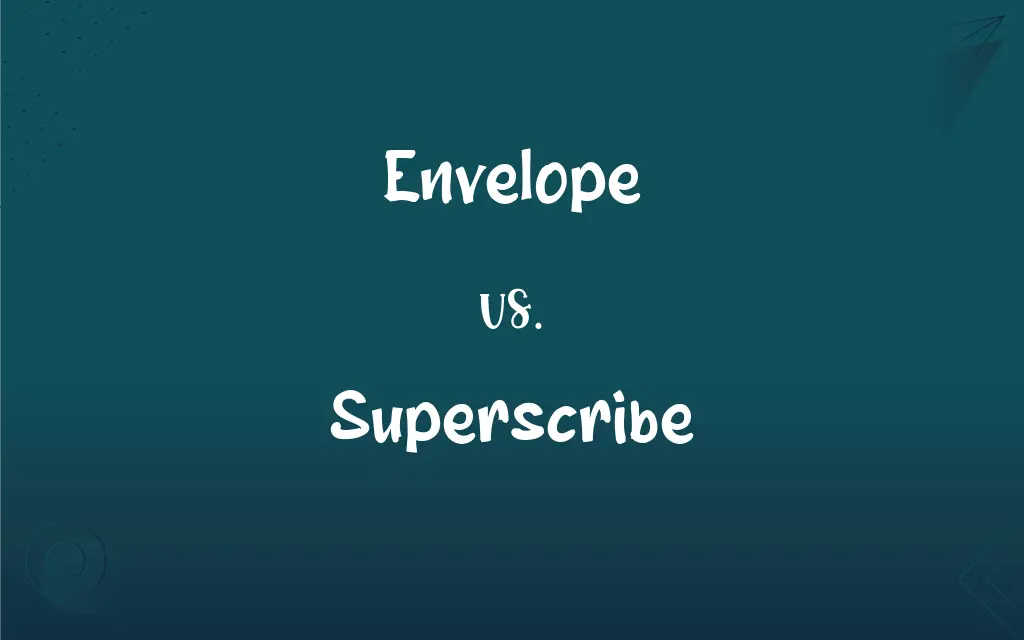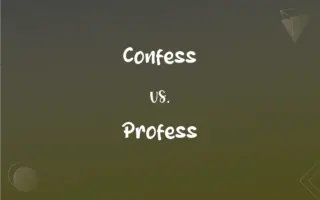Envelope vs. Superscribe: What's the Difference?
By Harlon Moss & Janet White || Updated on March 4, 2024
Envelope is a paper container for a letter, while superscribe means to write on the outside of an envelope or package.

Key Differences
An envelope serves as a protective cover for letters, documents, or cards, typically made of paper or cardstock. It is designed to conceal the contents, ensuring privacy and security during transit from sender to receiver. Superscribe, on the other hand, is a verb that refers to the action of writing or inscribing information on the outside of an envelope, package, or document. This information usually includes the recipient's name and address and may also involve additional postal instructions or markings that facilitate the delivery process.
While the envelope acts as a physical container for messages and documents, superscribing is a process that involves labeling or addressing the envelope to make sure it reaches its destination. The relationship between the two is complementary; an envelope protects the contents, and superscribing directs where and to whom those contents should be delivered.
In terms of usage, envelopes are tangible objects that users interact with physically. Superscribing is an action performed on the envelope (or package) as part of the preparation for sending mail. The effectiveness of an envelope in securing the contents and the success of the delivery largely depend on the clarity and accuracy of the superscription.
Despite the advent of digital communication, envelopes remain relevant for physical mail, official documents, and personal letters that require a touch of formality or confidentiality. Similarly, the practice of superscribing is indispensable in the context of postal services, courier deliveries, and even in historical documents where it signified ownership or origin.
Comparison Chart
Nature
Noun (object)
Verb (action)
ADVERTISEMENT
Purpose
To contain and protect letters or documents
To write or inscribe on the outside of an envelope or package
Usage
In mailing, to secure and privatize content
In preparing mail, to ensure delivery to the correct recipient
Relevance
Fundamental in traditional and formal correspondence
Crucial for the mail delivery process
Relation
Physical container for mail
Process of addressing or labeling the container
Envelope and Superscribe Definitions
Envelope
A variety of sizes and styles for different purposes.
He chose a large envelope for the manuscript.
ADVERTISEMENT
Superscribe
To write an address on an envelope.
She superscribed the envelope with elegant handwriting.
Envelope
A means to ensure privacy in communication.
Confidential documents were sent in a secure envelope.
Superscribe
In historical contexts, to mark ownership.
Ancient manuscripts were often superscribed with the owner's name.
Envelope
A flat paper container, especially for a letter, usually having a gummed flap.
Superscribe
The act of labeling for postal services.
He carefully superscribed the package to avoid any delivery errors.
Envelope
Something that envelops; a wrapping.
Superscribe
To add postal instructions.
Please superscribe 'Fragile' on the box before shipping.
Envelope
(Biology) An enclosing structure or cover, such as a membrane or the outer coat of a virus.
Superscribe
To write on the outside or upper part of (a letter, for example).
Envelope
The bag containing the gas in a balloon or airship.
Superscribe
To write (a name or an address, for example) on the top or outside.
Envelope
The set of limitations within which a technological system, especially an aircraft, can perform safely and effectively.
Superscribe
(transitive) to write on the exterior of, the surface of, or above.
He superscribed each character with its Latin-alphabet equivalent.
Envelope
A usually spherical region of interstellar matter surrounding a forming star and interacting with the star's gravitational and radiation fields.
Superscribe
(transitive) to write (something) on the exterior of an object, such as a document or an envelope.
His wife superscribed her own notes on each of his letters before sending them in packets to the editor.
Envelope
The coma of a comet.
Superscribe
(transitive) To address (an envelope etc.).
Envelope
(Mathematics) A curve or surface that is tangent to every one of a family of curves or surfaces.
Superscribe
To write or engrave (a name, address, inscription, or the like) on the top or surface; to write a name, address, or the like, on the outside or cover of (anything); as, to superscribe a letter.
Envelope
A paper or cardboard wrapper used to enclose small, flat items, especially letters, for mailing.
Superscribe
Write on the top or outside;
Superscribe one's name and address
Envelope
Something that envelops; a wrapping.
Superscribe
Write on the outside or upper part of;
Superscribe an envelope
Envelope
A bag containing the lifting gas of a balloon or airship; fabric that encloses the gas-bags of an airship.
Superscribe
A step in mail preparation.
After writing the letter, the next step is to superscribe the envelope accurately.
Envelope
(geometry) A mathematical curve, surface, or higher-dimensional object that is the tangent to a given family of lines, curves, surfaces, or higher-dimensional objects. Category:en:Curves
Envelope
(electronics) A curve that bounds another curve or set of curves, as the modulation envelope of an amplitude-modulated carrier wave in electronics.
Envelope
(music) The shape of a sound, which may be controlled by a synthesizer or sampler.
Envelope
(computing) The information used for routing a message that is transmitted with the message but not part of its contents.
Envelope
(biology) An enclosing structure or cover, such as a membrane; a space between two membranes
Envelope
(engineering) The set of limitations within which a technological system can perform safely and effectively.
Envelope
(astronomy) The nebulous covering of the head or nucleus of a comet; a coma.
Envelope
An earthwork in the form of a single parapet or a small rampart, sometimes raised in the ditch and sometimes beyond it.
Envelope
Archaic form of envelop
Envelope
That which envelops, wraps up, encases, or surrounds; a wrapper; an inclosing cover; esp., the cover or wrapper of a document, as of a letter.
Envelope
The nebulous covering of the head or nucleus of a comet; - called also coma.
Envelope
A work of earth, in the form of a single parapet or of a small rampart. It is sometimes raised in the ditch and sometimes beyond it.
Envelope
A curve or surface which is tangent to each member of a system of curves or surfaces, the form and position of the members of the system being allowed to vary according to some continuous law. Thus, any curve is the envelope of its tangents.
Envelope
A set of limits for the performance capabilities of some type of machine, originally used to refer to aircraft; - it is often described graphically as a two-dimensional graph of a function showing the maximum of one performance variable as a function of another. Now it is also used metaphorically to refer to capabilities of any system in general, including human organizations, esp. in the phrase push the envelope. It is used to refer to the maximum performance available at the current state of the technology, and therefore refers to a class of machines in general, not a specific machine.
Envelope
A flat rectangular paper container for papers
Envelope
Any wrapper or covering
Envelope
A curve that is tangent to each of a family of curves
Envelope
A natural covering (as by a fluid);
The spacecraft detected an envelope of gas around the comet
Envelope
The maximum operating capability of a system;
Test pilots try to push the envelope
Envelope
The bag containing the gas in a balloon
Envelope
A flat paper container for a letter.
She sealed the letter inside a matching envelope.
Envelope
Used in both personal and official mail.
Official correspondence was dispatched in a formal envelope.
Envelope
An element of postal tradition.
The art of letter-writing includes selecting the right envelope.
FAQs
Can any material be used for envelopes?
While paper is most common, envelopes can also be made from other materials like plastic, cloth, or even metal for special purposes.
What happens if an envelope is not properly superscribed?
Improper superscription may lead to mail being returned to the sender, delayed, or lost.
Are there environmental concerns with using envelopes?
Yes, the production and disposal of paper envelopes raise environmental concerns, prompting interest in recycled materials and digital alternatives where possible.
Can digital tools be used to superscribe an envelope?
Yes, printers can be used to print addresses directly onto envelopes, and there are digital services that prepare and send physical mail on behalf of users.
How has the role of envelopes changed with digital communication?
While digital communication has reduced the volume of traditional mail, envelopes are still crucial for formal, legal, and personal communications requiring a physical presence.
Can envelopes be reused or recycled?
Yes, envelopes can often be reused or recycled, depending on the material. Many people reuse envelopes for informal purposes or recycle them along with other paper products.
What is the significance of the window on some envelopes?
The window on some envelopes allows the recipient's address, printed on the document inside, to be visible. This design saves time and ensures accuracy in addressing for bulk mailings.
Why is it important to superscribe an envelope correctly?
Correct superscription ensures that the mail is delivered to the intended recipient without delay or confusion.
Are envelopes only used for letters?
No, envelopes can also contain cards, invitations, documents, and small items, depending on their size and design.
Is there a standard format for superscribing an envelope?
Yes, postal services recommend specific formats for addresses to optimize mail sorting and delivery, usually including the recipient's name, address, city, state, and postal code.
What should be considered when choosing an envelope for sensitive documents?
For sensitive documents, consider using security envelopes with features like opaque materials or patterns that prevent the contents from being seen through the envelope.
What innovations exist in envelope design for environmental sustainability?
Innovations include envelopes made from recycled paper, biodegradable materials, or incorporating reusable features to extend their life cycle and reduce waste.
What tips can improve the accuracy of superscribing for international mail?
For international mail, include the country in capital letters at the bottom, use clear and legible handwriting or print, and follow the address format of the destination country to improve accuracy.
How does superscribing relate to modern courier services?
In modern courier services, superscribing includes not only writing the address but also attaching barcodes or QR codes that facilitate tracking and delivery.
How has the digital age impacted the use of traditional envelopes?
The digital age has led to a decrease in the use of traditional envelopes for everyday communication, shifting towards email and electronic documents. However, envelopes retain their importance for formal, legal, and certain personal communications.
Are there any legal requirements for superscribing envelopes in specific industries?
In industries like healthcare and finance, legal requirements may dictate how envelopes should be superscribed to protect confidentiality, such as using nondescript return addresses or secure delivery methods.
How do you properly dispose of envelopes with plastic windows?
Disposal methods vary by location, but generally, it's recommended to separate the plastic window from the paper portion of the envelope before recycling if possible. Some recycling programs accept envelopes with windows intact.
What are the cultural significances of envelopes in different societies?
In some cultures, envelopes have significant roles beyond mail, such as the tradition of giving money in red envelopes during certain Asian festivals or weddings, symbolizing good luck and prosperity.
Is it necessary to use an envelope for all types of mail?
Not all types of mail require an envelope; postcards and certain forms of direct mail are designed to be sent without one. However, envelopes are essential for maintaining privacy and protecting the contents in most other cases.
Can technology automate the superscribing process?
Yes, technology can automate superscribing through the use of address printing machines and software that organize and print addresses directly onto envelopes, improving efficiency for large mailings.
About Author
Written by
Harlon MossHarlon is a seasoned quality moderator and accomplished content writer for Difference Wiki. An alumnus of the prestigious University of California, he earned his degree in Computer Science. Leveraging his academic background, Harlon brings a meticulous and informed perspective to his work, ensuring content accuracy and excellence.
Co-written by
Janet WhiteJanet White has been an esteemed writer and blogger for Difference Wiki. Holding a Master's degree in Science and Medical Journalism from the prestigious Boston University, she has consistently demonstrated her expertise and passion for her field. When she's not immersed in her work, Janet relishes her time exercising, delving into a good book, and cherishing moments with friends and family.































































